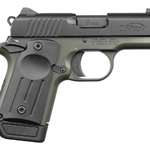After the summer and early fall of 1914, when it became clear that the Great War was settling into the stalemate that would forever characterize it, the need for arms to fuel the conflict became more pronounced. To solve a glaring shortage of sidearms, the French government reached out to gunmakers in Spain's Eibar region for stopgap solutions. The gun they selected would be made in huge numbers and is known today as simply the "Ruby." Watch our "American Rifleman Television" I Have This Old Gun segment above to see the Ruby on the range.
"At the start of World War I, the standard issue pattern gun in the French military arsenal is the Model 1892 revolver. And it's clear that there's not nearly enough to put one in the hands of every officer that's going to the front," American Rifleman Executive Editor Evan Brune said. "And so in 1915, the French approach Gabilondo y Uresti, which is one of many makers in the Eibar region of Spain that is known for making small, pocketable handguns."
Gabilondo's Ruby pistol was a semi-automatic handgun chambered for the .32 ACP cartridge, and this design would typify the Ruby pistols used during World War I.

"To make a long story short, they discovered that the Spaniards were making basically what was a copy, a rip-off copy of the Colt 1903 Auto Pistol, a superb gun. And they called it a Ruby. That was their, kind of their trade name on it," American Rifleman Field Editor Garry James said. "Very, very well built. .32 ACP. It held one round more than a regular 1903 Colt, and the French looked at that and they said this is just the ticket. This is just what we need for our troops. So they ordered thousands and thousands of them."
However, the Spanish firm quickly realized that there was going to be an issue with supplying the French with the huge quantities of pistols they needed in such a short time frame. An initial order of 130,000 Ruby pistols overwhelmed the Gabilondo firm, so the Eibar-based manufacturer contracted with several other makers in the area to increase production.

"Problem is that word gets out that the French are in desperate need of guns, and there are dozens of makers in the Eibar region of Spain who are capable of producing exactly the kind of pistol that the French military need," Brune said. "And so all of them start submitting these guns, or patterns of these Ruby guns to the French government, and the French start buying them from basically anyone that is willing to make them."
Ultimately, nearly 50 Spanish gunmaking firms would produce Ruby-style handguns for the French throughout World War I and afterward. While most of the guns conformed to a certain style, each company's version had its own unique elements, and quality varied between the different makers.
"Having 50 different manufacturers at that day and age did not lend well to interchangeability of parts, to uniform manufacturing," NRA Museums Director Philip Schreier said. "Even down to the magazines had to be stamped with the name of the original manufacturer because they wouldn't interchange, which creates an interesting conundrum for collectors today who want to shoot Rubys. You gotta make sure you're shooting one that has all the original parts."
To watch complete segments of past episodes of American Rifleman TV, go to americanrifleman.org/videos/artv. For all-new episodes of ARTV, tune in Wednesday nights to Outdoor Channel 8:30 p.m. and 11:30 p.m. EST.






















